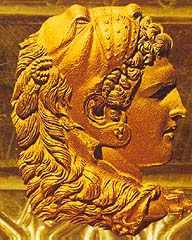|
|
|
|
|
|
4.000
years of Greek History and Civilization
|
|
In
Halkidiki, in Petralona Cave, the remains were found
of the first man to inhabit Greece. He lived on for
tens of thousands of years with stones as his only tool.
Life took on another aspect in the Neolithic era. By
then men and women were born and died in sun-dried brick
houses roofed with branches and reeds. They founded
settlements and cultivated the earth. In their hands,
clay became a means of making utensils and art. The
small clay idols from Nea Nikomidia (6.000 BC) and the
clay heads from Drama (4.000 BC) reveal their sensitivity
and their attempts at self-expression.
|
|
|

|
Around
the year 2.300 BC, new groups of people
appeared in Macedonia. And the fate of the
Greeks can be discerned in their traces.
Little by little they learned to use metals,
bronze to start with, later iron. Iron weapons,
bronze jewelry, decorative objects found
in the funeral mounds at Vergina, indicate
the level of civilization that those people
had reached. This is how the "Macedonia
Nation" began. During the Archaic period,
colonies founded by the Greeks of the south
brought Macedonia into closer contact with
the rest of the Greek world. Pottery from
Corinth and Athens traveled to Macedonia
along with architectural elements from Ionia.
In the Classical era, the influence of southern
Greece became even more fertile and creative.
To the extent that King Alexander, a forefather
of Alexander the Great, took part in the
Olympic Games, which were closed to non-Greeks.
|
|
|
|
The
palace of Vergina played host to philosophers, poets,
painters and musicians. Aristotle opened the way to
European thought. Masterpieces influenced by the creative
works of the Ionians took on a different form in the
hands of local artists. Cities were built according
to perfected plans. Painters gave us inspired works
on the walls of the palaces and royal tombs. Craftsmen
did wonders with gold. This art eventually spread to
the far reaches of East and was assimilated by the populations
there together with memories of Alexander. The Great
King lived on in hosts of myths lodged in the imagination
of medieval man and were passed on to Renaissance Europe.
Christianity came to Macedonia when it was still in
its infancy, brought by St. Paul himself, who traveled
and taught on its soil. Thessaloniki became the second
city of Byzantine Empire. Grand and magnificent civic
monuments, churches and monasteries were erected throughout
Macedonia. The early basilicas were followed by ecclesiastical
architecture of all types. At Kastoria there are dozens
of churches whose interiors are decorated with the glowing
portraits of archangels, saints and donors; In Veria,
the church of Christ is famous for its colorful compositions;
while nothing can compare with the jewels of the monastic
state of Mt. Athos. In Thessaloniki such monuments abound
: there are fifty-seven churches and forty monasteries
and dependencies, where the floorsare decorated with
mosaics and vaulted ceilings with angels trumpeting
to the heavens. Everywhere you look there are examples
of Byzantine architecture and painting. In Turkish-occupied
Macedonia, everything came to a halt until the moment
when the Greeks were able to acquire some control over
the region's economy in the 18th century. The art of
that era relied on the inspiration of the local craftsmen,
whose superb work can be seen in the carved doors, pottery,
costumes, gold and silver jewelry. You can see them
in Macedonia's old mansions and churches. The icons
painted then show such fear in the Virgin's expression,
fear for the fate of the Babe that she holds, the fate
of her enslaved people. The conquerors swept through
Macedonia, pillaging as they went, until the day came
when they were subdued by the effect of the civilization
they encountered, which always had something new to
show them.
|
| | |